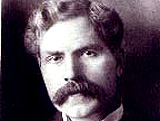James Ramsay MacDonald 1924 and 1929-35 Labour
 Born: 12 October 1866 in Lossiemouth. Morayshire
Born: 12 October 1866 in Lossiemouth. Morayshire
First entered Parliament: 16 January 1906
Age he became PM: 57 years, 102 days; 62 years, 236 days
Maiden Speech: 5 March 1906 attacking the examination syllabus for factory inspectors
Total time as PM: Six years, 289 days
Died: 9 November 1937 on the liner Reina del Pacifico on holiday during the crossing of the Atlantic
Multimedia
Ramsay MacDonald appeals for support
Watch Ramsay MacDonald appeal for support for the National Government in 1931. You can watch more history videos here.
Facts and figures
Education: Church of Scotland school in Drainie, evening classes at Birkbeck Institute
Family: Ramsay MacDonald was an only child. He was married to Margaret Ethel Gladstone, and had three sons and three daughters
Interests: Golf, walking and literature.
Biography
Life in the classroom
Ramsay MacDonald, the first Labour PM, came from a working class family and grew up in Lossiemouth.
He worked as a teacher at the local board school he attended, and at 18 moved to Bristol as a clergymans assistant, where he joined the Social Democratic Federation.
MacDonald was employed as a Liberal candidate's assistant in London for three years, and joined the Independent Labour Party in 1893. He stood unsuccessfully as a parliamentary candidate in 1895, meanwhile working as a journalist. But with the encouragement of his new wife, Margaret, he rose through the party ranks.
 Elected for Leicester in 1906, MacDonald established a reputation as a distinguished thinker. In 1911 he became chairman of the parliamentary Labour group.
Elected for Leicester in 1906, MacDonald established a reputation as a distinguished thinker. In 1911 he became chairman of the parliamentary Labour group.
As the Labour Party grew, however, he was criticised as being too moderate. His opposition to the Great War made him more unpopular still, and he was mercilessly attacked by the press.
MacDonald lost his seat in 1918, but later returned to represent a Welsh mining constituency. Back in Parliament, he became party leader and therefore Leader of the Opposition, and in 1924 was asked by George V to form a government when Stanley Baldwin's small Conservative majority proved ungovernable.
In the first-ever Labour government the survival of MacDonald's small Commons majority depended on the good will of opposition parties. This difficult situation prompted him to call an election.
During the campaign a newspaper published the notorious 'Zinoviev' letter. Although later accepted to be a fraud, the letter ruined MacDonald's anti-Communist credentials.
His Labour administration was then heavily defeated in the election.
Mysterious infection
In 1927 he had a mysterious throat infection and almost died on a visit to the United States. He spent a month at a hospital in Philadelphia and recovered.
In his second minority government in 1929, MacDonald set an historic precedent by appointing Margaret Bondfield as the first female minister.
Economic crises, including the doubling of unemployment levels, persuaded him to include the opposition leaders in a cross-party National Government.
However, this step lost him the support of his own party and he resigned in 1935.
The coalition was considered by many party members to be a cynical betrayal of their hopes. MacDonald subsequently lost his seat.
He then fought to return to Parliament, winning a by-election two years before his death on the way to South America in 1937.
Quote unquote
"We hear war called murder. It is not: it is suicide"
Did you know?
He was survived by his children, one of whom, Malcolm MacDonald, had a successful career as a Cabinet Minister in his own right.
Wife
Before her marriage, Margaret was involved in social work in East London. She played an active part in the Women's Labour league. The couple had six children.
The previous Prime Minister
Stanley Baldwin 1923, 1924-9, 1935-7 Conservative

 PM's Biography
PM's Biography PM Record Breakers
PM Record Breakers Take a tour of Number 10
Take a tour of Number 10 Useful Links
Useful Links